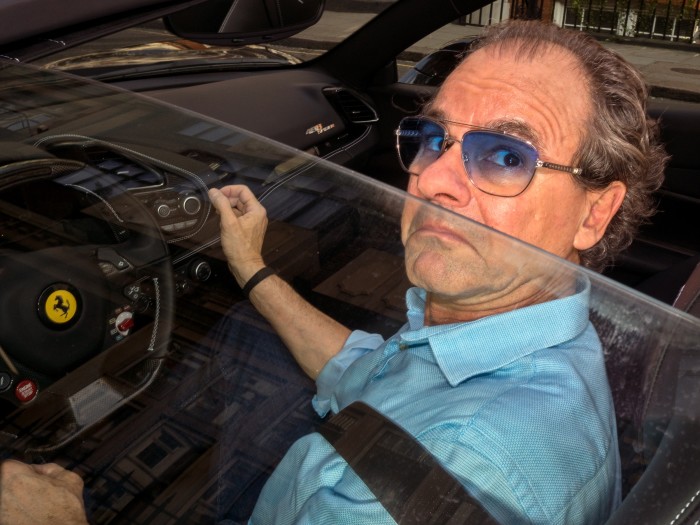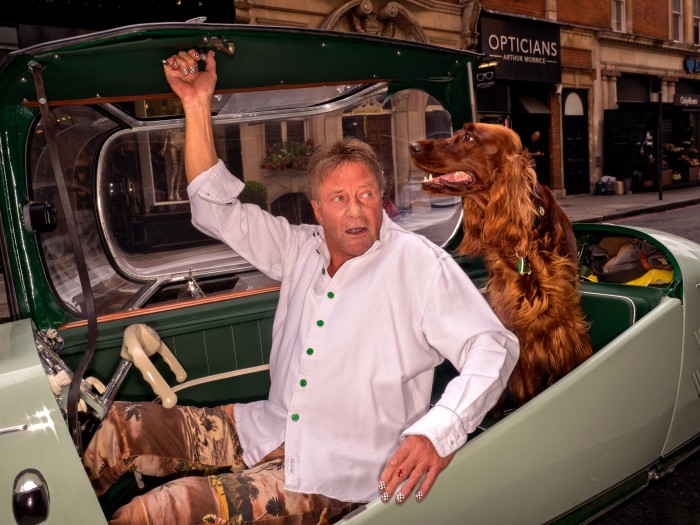Meet the supercar spotters

Roula Khalaf, Editor of the FT, selects her favourite stories in this weekly newsletter.
London’s air feels a little smoggier today. Which means the supercars have begun to cruise through Knightsbridge once again. They roll past Harrods, growl down Sloane Street and lounge on double-yellow lines, engines on. They rarely speed or streak along these thoroughfares – not unless asked, at least. The purpose is to peacock. Because if no one sees a supercar, was it ever really there in the first place?
First popularised around 2010, supercar spotting involves hanging around on big-money streets, waiting to take pictures of big-money cars. What is a spotter looking for? Each has a different stipulation. Most are seeking a road-safe racing car that goes from 0 to 60 mph in less than five seconds and costs more than £100,000. Valued at around £16mn, the McLaren F1 is considered one of the best supercars of all time thanks to its V12 engine and relative scarcity (only 106 were made). The Nissan GT-R, which can hit 200mph, is less “canon” than some others as it only costs about £90,000.


You can car spot anywhere, but Knightsbridge and Mayfair are the meccas. From spring until September, hundreds of cars – Ferraris, Lamborghinis and Bugattis – are flown to London from Arab states as a way to escape the desert heat. (UK-based Autoshippers offers an air freight service from £5,408 per car.) A dedicated spotter might catch 50 supercars a day during this period; in winter, the numbers are more like 15. Hotspots include the traffic lights opposite Knightsbridge station, Lowndes Square and the road verge that separates Park Lane. Just look for the man (for it is usually a man) holding a camera.
The spotting community, I’ve learned, is a closed one. I have been trawling these streets for the past six months, risking traffic and making light of dual carriageways, and I haven’t made any friends on the circuit. Those who have spoken to me have done so distractedly: it’s not uncommon for someone to leave, mid-conversation, to chase after a pink Lamborghini. They seldom come back. On one occasion I waited outside Harrods for 20 minutes so that George, a 21-year-old spotter, could use the bathroom, only to discover he’d given me the slip and headed out of another exit.


Spotting might sound simple on paper, but finding “good content” requires a few tricks. And with supercar spotting, it’s all about the content. If you spot a supercar at the junction where Sloane Street meets Pont Street, run to the set of traffic lights by Cadogan Place and wait there; you’ll get the first shot when it eventually drives down. I learn this from William, a fiftysomething engineer who hangs back from a rowdier group near the Millennium Hotel. Another tip: type “#liveupload” into Instagram’s search bar and find out where people are posting from. Serious spotters consider this method passé, but it’s a good place to start.
Tim Burton (not the film director) – aka Shmee150 – started uploading photos of cars to Facebook in 2008, and quickly accumulated a following. Today he has more than 2.4mn YouTube subscribers, who tune in to watch him test drive new models, meet fellow fanatics and, on one occasion, take part in a Croatian police convoy. But the best thing about Shmee is his own personal car collection, a 20-strong “Shmuseum” worth more than $8mn, most of it funded through advertising revenue, sponsorship deals and consultancy work for car brands. “The idea of a Ferrari or a Lamborghini is something inspirational to aim for in life – a target,” says Shmee, whose latest acquisition is a mustard-yellow Lotus Emira First Edition.

Shmee took supercar spotting, a relatively unknown hobby, and turned it into a profitable enterprise. Everyone I meet knows him; everyone aspires to a similar future. Unlike train spotters who simply enjoy the meditative activity of watching railway lines, most supercar spotters are in it for the money. For online marketer Andrew, 45, who has been spotting for almost four years, the goal is to become “rich and famous”. Each weekend he comes to Knightsbridge to film content for his fledgling channel, “even when [his] fingers are too cold to press the record button”. Once a channel hits 1,000 subscribers and 4,000 hours of watched content within 12 months, the owner can apply for the YouTube Partner Programme. Those accepted make around $4.20 per 1,000 views; Shmee’s channel has more than 1bn. But most of all, Andrew just really likes cars. He watches a Lamborghini Huracán STO pass by with the wistful eyes of a lover.
It’s hard to surmise the relationship between spotters and supercars. But a huge part of it is to do with freedom: cars have long been symbols of personal mobility. Add that to a six- or seven-figure price tag and Batmobile-style scissor doors and the results are irresistible. “Cars are a very emotional thing,” says Shmee extravagantly. “The sound, the feeling – the idea of what they can achieve, what they’re capable of – captivates the imagination.”

Not everyone will agree – least of all the long-term residents of Park Lane. There is a long, documented struggle between supercar owners and west-Londoners, many of whom have set up campaign groups against noisy revvers and boy racers. “People are not sleeping until three or four in the morning,” Karen, a Knightsbridge local, told AFP News Agency in the early stages of the spotting craze. “There’s a lot of testosterone going up and down Sloane Street,” added her daughter, Alexandra, who wore periwinkle eyeshadow and a pearl necklace. “This is probably one of the few times in my life where I’m glad to be deaf.”
If not testosterone, then there’s certainly braggadocio. Often I try counting the number of supercars with parking tickets: I quickly lose count. One culprit, an orange Lamborghini Aventador, has the word “WE04 PON” for a number plate. Another has a sticker inviting fans to follow him on Instagram. Outside Harrods, I question Abdulaziz, who drives a crimson Ferrari, on what it is about the supercar that sets his pulse racing. “Why do you get up in the morning and go to work?” he responds. By Abdulaziz’s expression, it’s apparent he only does so for the love of his vehicle.
Dedicated spotters have better relationships with owners, who have been known to offer rides and stage personal photo shoots. Shmee, who has been on both sides of this arrangement, advises “being polite, friendly” and, above all, respecting an owner’s privacy. “There’s a temptation to go exploring where you shouldn’t.” Cars are kept in a handful of private garages scattered across the city, most famously Windrush’s secret “bat cave” in west London. And good luck getting any intel on that.

Photographer Josh Scoot, 21, has become such a hit with supercar owners that he’s toured the garages of not only Shmee, but American car show host Jay Leno and entrepreneur Richard Rawlings of Gas Monkey Garage. Scoot is what you might call a collector: his early days were spent travelling London with a pen and paper, keeping a note of supercars and their various editions. His first major spot was a Zonda Cinque, one of just 10 models made including the Cinque Roadsters. Today, he’s seen four. “Fingers crossed I can see all 10,” he says, an unlikely feat given that most are “kept underground, collecting dust, as they’re so rare.”
When Scoot started spotting as a teenager, he found the hobby difficult to explain. “I didn’t have any confidence to tell even my closest mates,” says Scoot, who drives a Ford Fiesta; his “poster car” is a Ferrari 458. The experience led him to launch a series exploring bullying, discrimination and mental health on car enthusiast platform Petrolheadonism. Despite its closed ranks, those that do break into the super-spotter clique find the camaraderie to be the nicest thing about supercar spotting. “You see the same people every week,” says Tom, 16, of the hundreds of WhatsApp groups born out of spotting. Shmee also brings spotters together with regular car events; unsurprisingly, he calls them “Shmeetings”.


As the community has grown, so have the supercars. With UK ownership expanding by around 20 per cent in recent years, brands have stepped up their technology in pursuit of better track times. “Factory-manufactured Ferraris no longer turn heads,” says Botho Stein, general manager of The May Fair Hotel, who has seen traction in “bespoke and custom-made cars such as Aston Martin One-77, Porsche 918 Spyder and Bugatti Chiron” outside his hotel. At Lamborghini, where global sales are up 10 per cent, the recent Sián FKP 37 (£2.6mn), has a carbon-fibre body, V12 engine and weighs just 1,645kg. All units sold out before their unveiling. Wilder still are limited-edition models by Ferrari, McLaren and Aston Martin made without roofs or windscreens.
What do these changes mean for the supercar owner? The experience of driving these cars, one can assume, should be luxurious. “This is probably the thing that makes no sense,” giggles Shmee, “but the feeling of a supercar is generally one of being less comfortable. It’s noisier, vibrating; the seats aren’t so lovely and plush.” And yet. To drive one is to achieve a state that transcends all rhyme, reason and sensible spending. “You either get it or you don’t.”


While I still don’t quite “get it”, I certainly feel closer. To catch a supercar is to touch a world of limitless potential, where success stories abound and raw ambition is rewarded. Behind every supercar is someone who “made it”; every rev is a roar of triumph.
I return to Knightsbridge for a final time in February, when the supercar’s roar is more of an occasional bark. The past few months have been quieter than usual – “they’ve gone to Monaco”, says Andrew mournfully. And it’s true that the super-web is spreading. HR Owen’s £30mn Hatfield headquarters has created a new content-heavy hotspot. But the “rolling motor show of central London”, as Shmee calls it, will forever be the spotter’s heartland. Where else is a McLaren Senna as commonplace as a bright-red postbox?



Comments